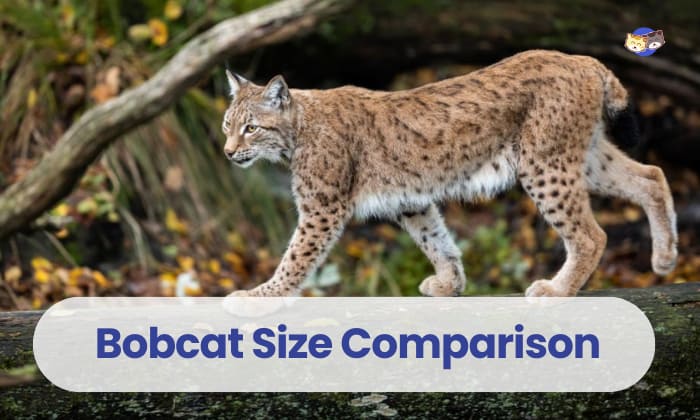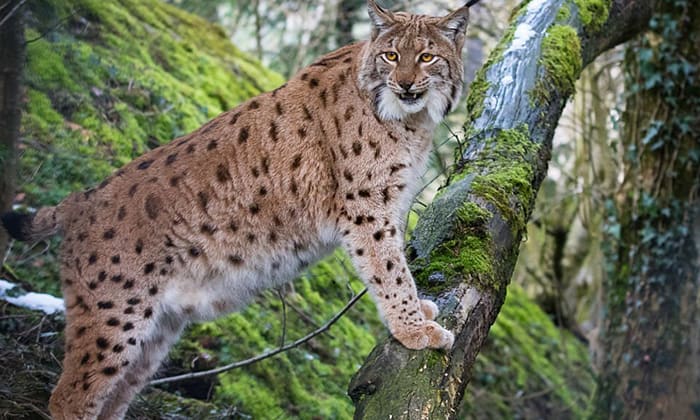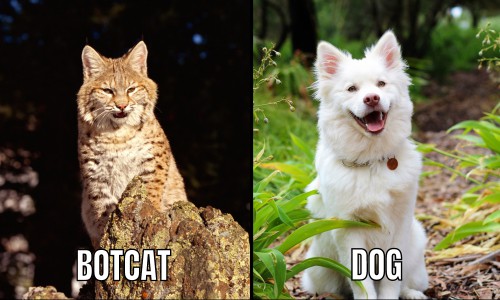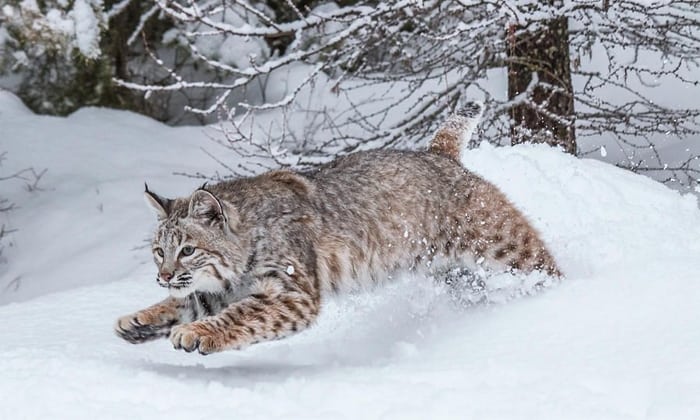Bobcats are large cats that look harmless due to their fluffy appearance. However, they are far from your gentle house cats.
These wild felines belong to the lynx species, which are large, fierce hunters. But have you ever wondered about a bobcat size comparison to other animals?
A bobcat is about twice the size of domesticated felines. They measure 2.3 to 3.08 feet long and about 15 inches tall. Although bobcats are large, they are smaller than most canines.
Table of Contents
How Big Are Bobcats?
Refer to this table to have a better understanding of how large is a bobcat:
|
Dimensions Of A Bobcat |
Baby bobcat |
Female Bobcat |
Male Bobcat |
Human |
|
Length (from nose to tail) (inches) |
1 – 2 |
28 – 32 |
32 – 37 |
|
|
Height (inches) |
2 – 4 |
20 – 40 |
20 – 50 |
61- 68 |
|
Weight (pounds) |
10 – 12 |
8 – 34 |
15 – 40 |
100 – 160 |
Bobcats (Lynx rufus) are medium-sized wild felines with sizes that can vary depending on their gender and subspecies.
As mentioned on the bobcat size chart above, a full-grown female bobcat has an average size of up to 32 inches long from its nose to tail and 37 inches high. Meanwhile, the males can grow as large as 37 inches long and 50 inches high.
The average weight of a bobcat depends on its gender – females are 8 to 34 pounds, while males are 15 to 40 pounds.
Moreover, some bobcats can grow larger than the average. The Eurasian lynx, the largest bobcat species, can grow up to 30 inches tall and weigh up to 80 pounds.
Read more: Bobcat kitten names
Bobcat Types and Their Sizes
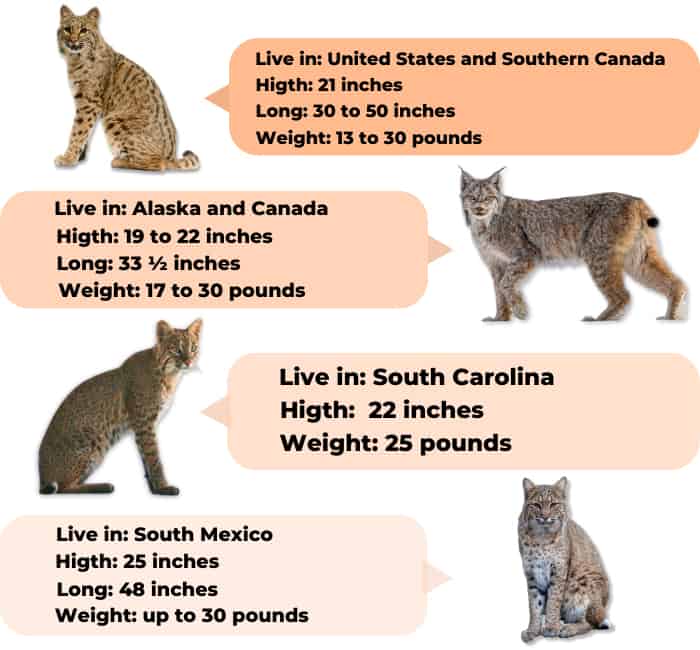
Bobcats have 12 subspecies, but only two are recognized: the Lynx rufus rufus and Lynx rufus fasciatus. Some of the most common bobcat subspecies and their size and weight.
- Eastern Bobcat (Lynx rufus rufus). Found in the United States and Southern Canada. On average, this wild cat can grow up to 21 inches high, 30 to 50 inches long, and weigh 13 to 30 pounds.
- Canadian Lynx (Lynx canadensis). Found in the forests of Alaska and Canada. They measure 33 ½ inches long, 19 to 22 inches high, and weigh 17 to 30 pounds.
- Southern Bobcat (Lynx rufus floridanus). Usually lives in heavily forested areas throughout South Carolina. These cats can grow up to 22 inches high and weigh up to 25 pounds.
- Mexican Bobcat (Lynx rufus escuinipae). Lives in South Mexico, hence the name. Mexican bobcats stand 25 inches high, 48 inches long, and weigh up to 30 pounds on average.
Mexican Bobcats are declared an endangered species.
Bobcat Size Comparison to Human
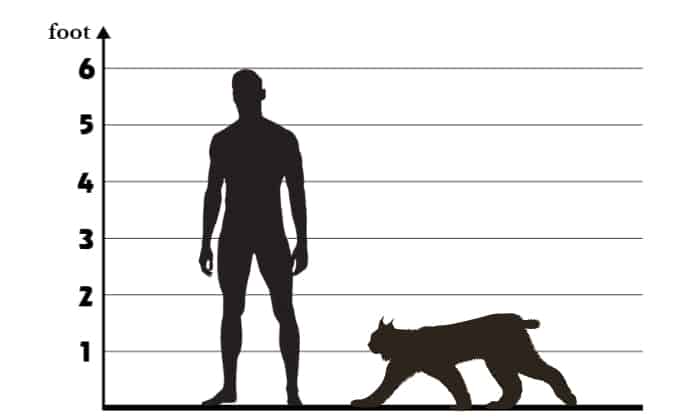
While bobcats are excellent hunters, they are not animals you’ll fear when you come across them. While they are large felines, full grown bobcats are only a quarter of the height of an adult person.
These cats are large enough to injure humans. But they cannot kill an adult person, as their canine teeth are only an inch long.
While their claws are sharp, they also only measure an inch long. So, these claws are not long enough to cause fatal puncture wounds.
If you carry a bobcat by its front feet while leaving its hind legs touching the ground, it is about as tall as a two-year-old.
Bobcats vs. Other Animals
|
|
Bobcat |
House Cat |
Lynx |
Mountain Lion |
|
Length (inches) |
28 to 37 |
18 to 20 |
32 to 40 |
84 to 108 |
|
Height (inches) |
20 to 50 |
9.1 to 9.8 |
24 on average |
24 to 36 |
|
Weight (pounds) |
8 to 40 depending on the gender |
8.8 to 11 on average |
Up to 60 on larger species |
64 to 220 depending on the gender |
1. Bobcat Size Vs. Wolf Size
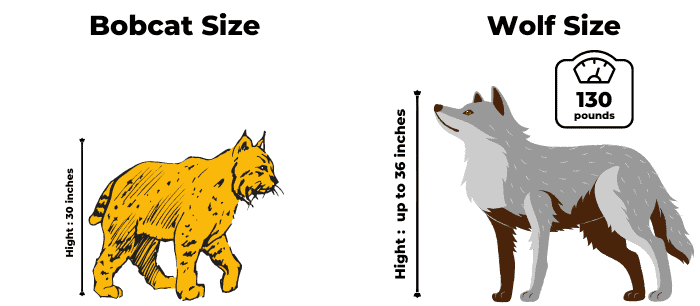
It is easy to tell that wolves are much larger than bobcats. The most common world species, the Gray wolf, can stand up to 36 inches tall and weigh up to 130 pounds.
Meanwhile, the largest bobcat is only 30 inches tall.
So, it would take several large bobcats to match the size of a single wolf.
But if you compare a bobcat to the Arabian wolf, which is the smallest species of wolf, you’ll see that the two animals are a match. Arabian wolves can only get as high as 26 inches.
2. Bobcat Size Comparison To Dogs
There are countless species of dogs, so it can be tricky to find their precise size difference from a bobcat. That said, let’s compare bobcats to one of the largest and smallest dog breeds – the Central Asian Shepherd Dog and the Pomeranian.
3. Bobcat Vs. Central Asian Shepherd Dog
These dog breeds are tall and massive, weighing 88 to 110 pounds and standing 25.5 to 27.5 inches tall on average. If this dog stood up on its hind legs, it could easily overshadow an averagely tall human.
Compared to a bobcat, this dog is significantly larger and heavier. It would be impossible for a bobcat to overpower, let alone attack, a Central Asian Shepherd.
4. Bobcat Vs. Pomeranian
A Pomeranian is among the smallest breeds of dogs, measuring only 6 to 7 inches tall. Since the height of a bobcat can reach 40 inches, it would take at least 7 to 8 Pomeranians to be as large as bobcats.
5. Bobcat Vs. Mountain Lion
Mountain lions are 84 to 108 inches long, while bobcats can only reach a length of 37 inches. Considering how tall mountain lions are, not to mention they can weigh up to 160 pounds, these giant felines can easily prey on and kill a bobcat.
6. Bobcat Vs. Coyote
Cayotes are only a bit bigger than bobcats. These wild canines weigh up to 40 pounds and are 30 inches high.
While some bobcat species can reach up to 50 inches tall, their average height is 24 inches. For this reason, coyotes and bobcats can be a match in the wild.
7. Bobcats Comparison To A Cat
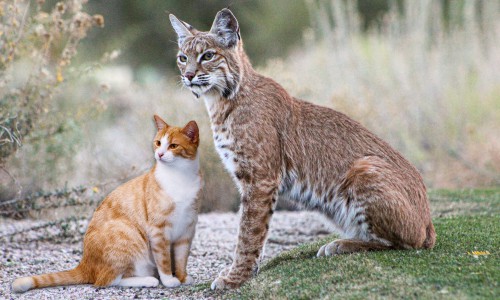
At first glance, bobcats look fluffy and cuddly. Their faces do not even look intimidating.
However, these wild cats are great predators that are about twice the size of a house cat. A bobcat compared to a house cat, the latter would look like a kitten due to the size difference.
8. Bobcat Size Vs. Lynx
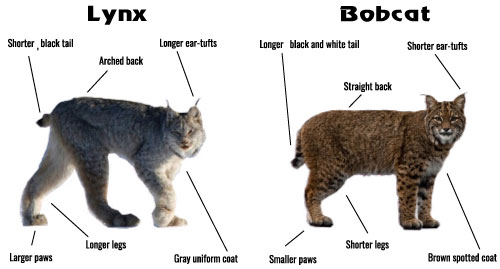
A bobcat and a lynx are closely related, but the latter is much larger. There is not much height difference, as the lynx stands 24 inches on average; they can weigh up to 60 pounds.
In contrast, a bobcat’s weight range is 8 to 40 pounds. Needless to say, lynxes are the larger cousins of bobcats.
A Bobcat’s Hunting Habits and Diet
Bobcats are carnivorous animals and primarily hunt small mammals such as rabbits, rodents, and birds. While uncommon, these felines may also prey and feed on animals larger than them.
In addition, bobcats are skilled and opportunistic hunters that usually look for prey at night. They stalk their prey before pouncing on it and delivering a fatal bite to the neck or head.
Apart from hunting, these wild animals may also scavenge for food left by predators that are larger than them. Small mammals are their primary food source, and they may even feed on domestic animals if accessible.
Frequently Asked Questions
Is a bobcat the big size of a dog?
Bobcats are bigger than small dog breeds but smaller than large breeds like the Pitbull and Great Dane. Compared to a Chihuahua, it would take eight of this smallest dog breed to match a bobcat’s size.
Are bobcats dangerous?
Bobcats are not as vicious as other wild animals. So, you should not fear them when you stumble across one.
But it is worth noting that they are still wild animals that are not used to human touch. So, if you see a bobcat in your neighborhood, you should never attempt to touch it.
Do bobcats attack humans?
Bobcats do not attack people. Similar to any other feral cats, they try to stay out of people’s sight by all means possible.
So, if you ever wonder, can a bobcat kill a human, the simple answer is no.
Bobcat lifespan
On average, a bobcat in the wild can live for about 13 to 15 years. However, their lifespan can vary depending on various factors such as their habitat, food availability, and the presence of predators or diseases.
Conclusion
A bobcat’s size may vary depending on location, food availability, and gender. However, these wild felines are generally smaller than their larger relatives, like lions and tigers.
Despite a bobcat’s size comparison with other animals, its size does not hinder its ability to hunt and survive in the wild. They are agile, quick, and powerful predators that can take down prey larger than themselves.

I am Amy Sawy, a Doctor of Veterinary Medicine (DVM) graduate from the University of Kansas. y husband, Dr. Plummer, and I own a veterinary clinic in Phillipsburg, Kansas. In addition to my professional background, I am a devoted pet owner myself, with a household that includes dogs, rodents, and most notably, cats – a total of five felines in my home.
In 2020, I joined an organization as a professional writer, leveraging my experience and collaborating with my team to deliver the most valuable information for your cat’s care.


